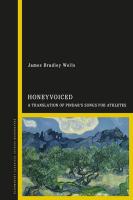
Bloomsbury Academic (2024) h/b 328pp, £100 (ISBN 9781350226401)
W. teaches at De Pauw University, Indiana, and has published on Pindar. He is also a poet. His 30-page introduction to the four books of epinicians (no fragments here) places Pindar in his cultural context and sets out the principles behind his own eye-catching versions. He also investigates and seeks to illuminate Pindar’s unique poetic style, and—inevitably, given Pindar’s lasting influence—touches on the notorious effusions of later European ‘Pindarique’ lyric poetry. Each ode is preceded by a useful paragraph explaining references in it—a basic commentary, in fact.
Here is W.’s translation of Pythian 9. 76-82, fairly typical of his whole oeuvre:
‘outstanding achievements are
always worthy
of wordlush
stories
it is a spectacle of sound
when poets
adorn the everyday
with transcendent art
attunement to the moment
likewise attains
the height of every terrain
sevengated
Thebai knew
that Iolaos did not
disdain
this creed
after he slew the head of Eurystheus
with swordedge
they buried Iolaos
beneath the earth
in chariotdriving Amphitryon’s tomb
where his father’s
father reposed
guest of Spartoi
when he moved
abroad to the streets
of Kadmos’ brighthorse people’
Several things strike the reader here. First, W.’s bizarre colometry, which neither helps understanding nor bears any relation to the best editions of the Greek. It is generally accepted by scholars that Pindar’s formal metrical structures were imperfectly understood in antiquity, even by his Alexandrian editors. Horace’s famous recusatio (Odes IV.2), comparing Pindar to a violently overflowing mountain torrent, was probably responsible for the bulk of later ages’ ‘Pindarizing’ outpourings of lyric enthusiasm as much because of the Greek’s appearance on the page as due to the poet’s elevated, abrupt, and richly metaphorical style. (Horace’s poetical stance as a ‘labouring bee from Mount Matinus’ is in fact a canny piece of professional positioning vis-a-vis Augustus.) Cowley and his like needed no encouragement to treat a page of Pindar as barely structured vers libre; his strict metrical patterning was not properly understood until August Boeckh’s major edition of 1811-21.
Second, the effect of W.’s punctuation-free effusions, doubtless designed to convey the onward movement of the original, has the effect of inducing a kind of breathlessness in the reader (the excerpt above has no full stops until the ode’s end, and not even then). It is true that reading Pindar does sometimes feel like being shown a rapidly shifting sequence of images and voices, but the pace is not constant: fervent elevated myth-telling is followed by gnomic utterance, lengthy praise of athletic skill by brief authorial homily. And there is no way an English translation can directly reproduce the patterning of an inflected language. Simply trying to hide the fact that Greek sentence structure starts and stops, and clearly indicates which adjective modifies which noun, makes no sense. Neither does W.’s explanation, that ‘absence of punctuation … brings poetry into proximity with the embodied experience of language, affording a more synesthetic encounter with the verse’.
More seriously and uncharacteristically—for W.’s versions stay pretty close to the Greek on the whole—is what he makes of lines 77-78. baia d’ en makrois poikillein / akoa sophois does not mean ‘it is a spectacle of sound / when poets / adorn the everyday / with transcendent art’ but ‘the embellishment of a few themes among many is what men of culture like to hear’. On this showing, there may be more howlers elsewhere.
The victory ode’s brief and brilliant outburst in antiquity continues to attract high-class scholarly comment, ranging recently from Richard Stoneman’s excellent 2014 introduction (Pindar) to the 2012 essay collection edited by Chris Carey et al arising from an earlier London conference on the epinician (Reading the Victory Ode). W. adds the occasional insight of his own but should be used with care. He accepts Gregory Nagy’s assumption that victory poems embody vestiges of a young man’s ritual initiation into manhood without wondering how middle-aged Sicilian autocrats’ (jockey-driven) chariot triumphs fit the theory. He calls oikia the young man’s home that enjoys the kleos (fame) which his victory brings, but the word he needs is surely genos; mothers may well have felt pride at their sons’ success, but they never figure in epinicians, nor do the family’s slaves. (The almost complete absence of women in Pindar causes W. some discomfort: in a burst of inappropriate virtue-signalling he wishes he could spare his readers the ‘distressing aspects’ of Pindar’s ‘systemic patriarchy and sexism’, and regrets his inability to replace the pronoun ‘him’ with ‘them’ throughout. One wonders why he chose such a male-dominated activity to translate and write about.) Lastly, I could find no reference to two vital aspects of Pindar’s writing: his insistence on the superiority of inborn (aristocratic) talent to learned skills, and—inexplicably—the kômos that often followed a young athlete’s victory.
Translation of Greek verse does not have to stick slavishly to the original to bring out its essence. Experiment has its place. W. is an experimenter, and some readers will find pleasure and stimulation in his attempt to bring Pindar closer to Greekless readers. There are, however, many reasons why prospective buyers of this book should let their hands hover a little over their £100 before taking the final plunge.
Anthony Verity
